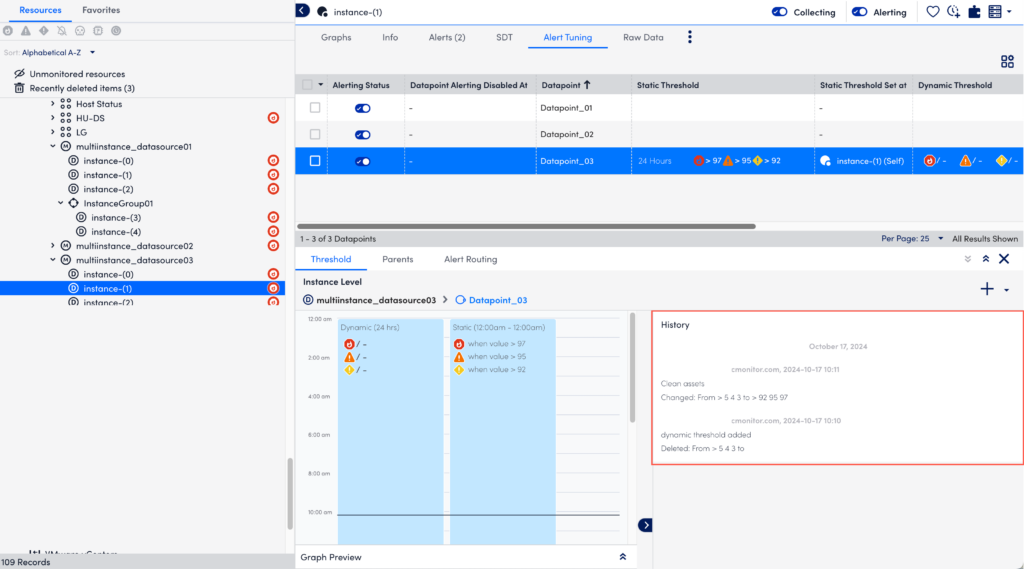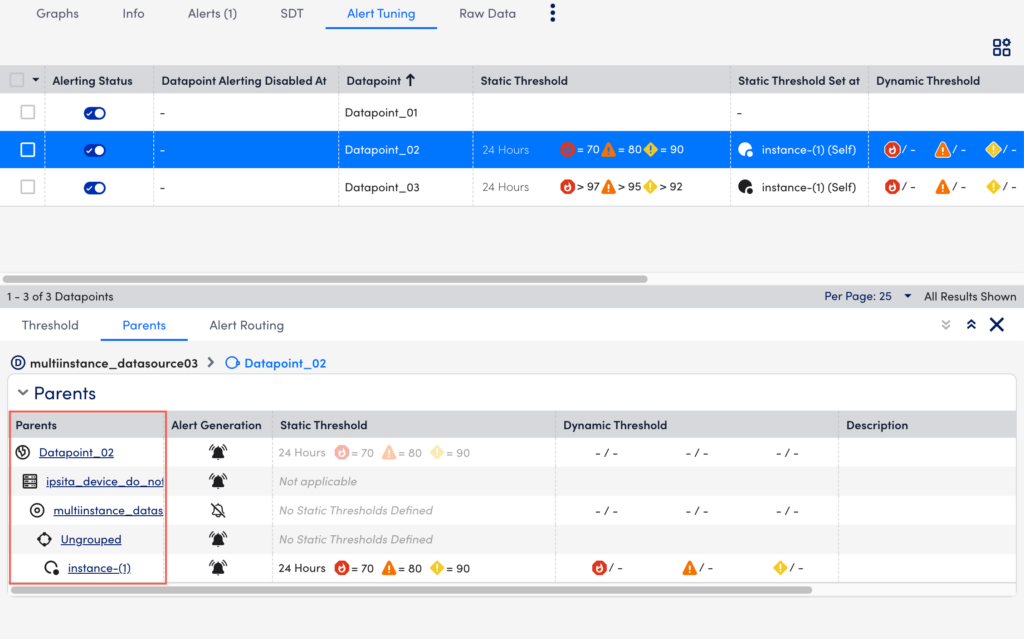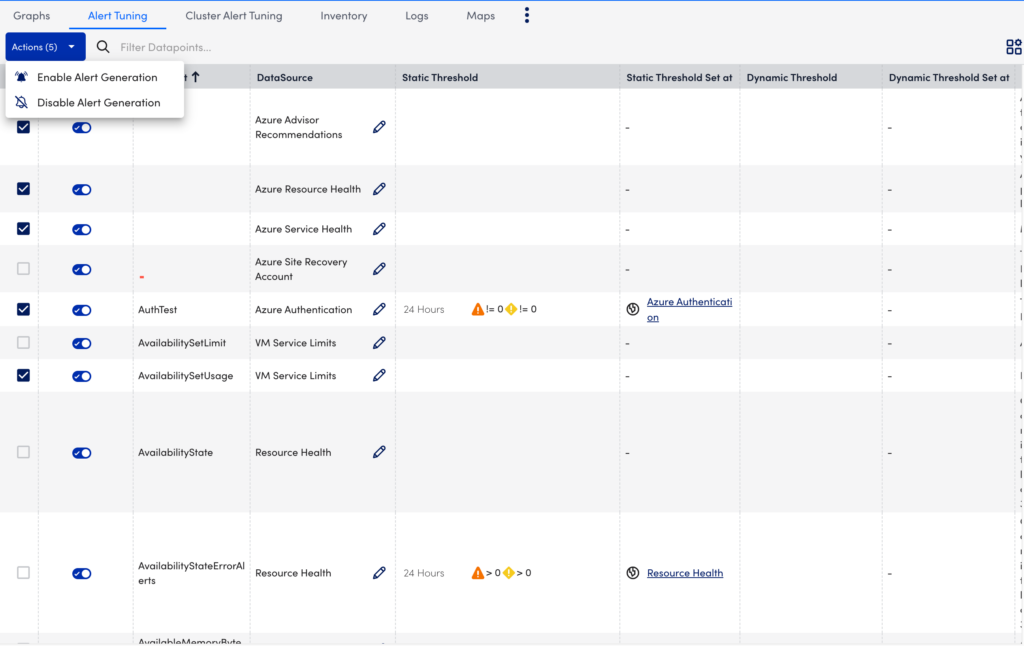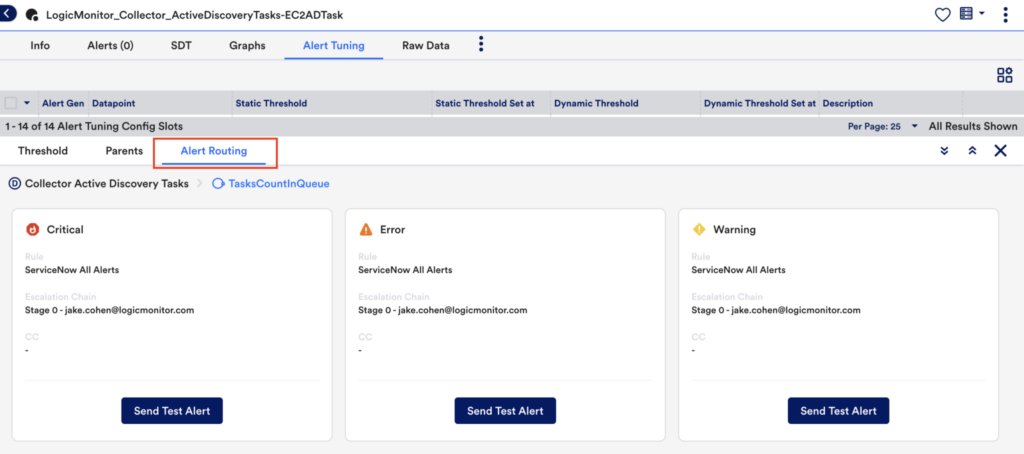Threshold Management
Last updated - 17 January, 2025
You can perform different activities such as viewing threshold history and hierarchy, editing, and deleting a threshold.
Requirements for Threshold Managment
- A user with the “Threshold” and “Manage” permissions set at the Resource group level.
In addition, if your environment leverages Access Groups for modules, you need the following:
- The user must have the “Resources: Group Threshold” permission set.
Viewing Threshold History
- In LogicMonitor, navigate to Resources Tree > Resources > select the required datasource.
- Select the Alert Tuning tab and then from the datapoint table, select the required datapoint.
- In the details panel, select the Threshold tab.
- Select the static or dynamic threshold.
The changes when adding a new or updating threshold are captured and displayed under History which includes the following:- Name of the user who made the changes
- Date and timestamp
- Nature of change – add or update
- Configuration change details

Note: If making threshold edits at the global DataSource definition level, the DataSource itself must ultimately be saved (requiring you to save at the wizard level, the datapoint dialog level, and ultimately the DataSource level) in order for the Threshold History log to be updated.
Viewing Threshold Hierarchy
- In LogicMonitor, navigate to Resources Tree > Resources > select the required datasource.
- Select the Alert Tuning tab and then from the datapoint table, select the required datapoint.
- In the details panel, select the Parents tab. Depending on the threshold configuration, the hierarchy is displayed.
You can view both static and dynamic thresholds configured for a datapoint. The global level threshold is placed at the top and follows the hierarchy: DataSource > Resource group > Resource DataSource > Instance group > Instance.

Editing Threshold
- In LogicMonitor, navigate to Resources Tree > Resources > select the required datasource.
- Select the Alert Tuning tab and then from the datapoint table, select
 for Threshold Editor.
for Threshold Editor. - To edit threshold settings, do the following:
- For datapoints at a given level with one threshold, edit the threshold through the static threshold form or the alerting parameter form with the required values and select Save.
- For datapoints at a given level with multiple thresholds, select Manage Threshold Settings and edit the thresholds with the required values and select Save.
Deleting Threshold
- In LogicMonitor, navigate to Resources Tree > Resources > select the required datasource.
- Select the Alert Tuning tab and then from the datapoint table, select the required datapoint.
- In the details panel, select the Threshold tab.
- Select the threshold that you want to delete.
- In the Edit Dynamic Threshold or Edit Static Threshold panel, select
 Delete Threshold.
Delete Threshold. - In the Delete Threshold dialog box, enter the threshold update note and select Delete.
Managing Alert Generation
- In LogicMonitor, navigate to Resources Tree > Resources > select the required datasource.
- Select the Alert Tuning tab and then from the datapoint table, select the required datapoint.
- To enable alert generation, do the following:
- Bulk update—Check the boxes of the required rows and select Actions to allow Enable Alert Generation and Disable Alert Generation for the selected datapoints.
- Individual update—Under the Alerting Status column, toggle the switch for the required row to enable or disable alert generation.

Sending a Test Alert
- In LogicMonitor, navigate to Resources Tree > Resources > select the required datasource.
- Select the Alert Tuning tab and then from the datapoint table, select the required datapoint.
- In the details panel, select the Alert Routing tab.
- Select Send Test Alert for the Critical, Error, and Warning alerts
Note: You can send test notification for cluster alerts. For more information, see Cluster Alerts Routing and Notification


